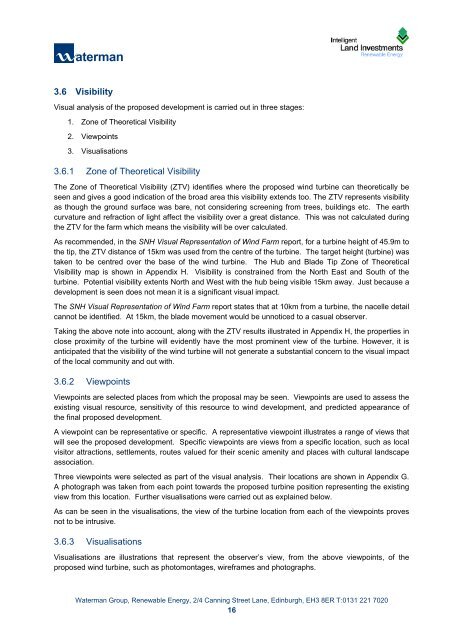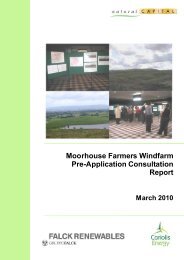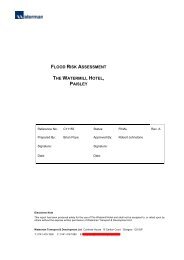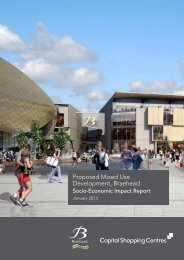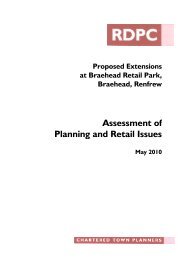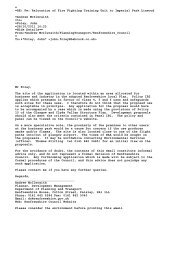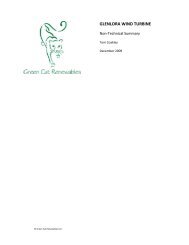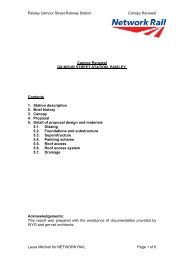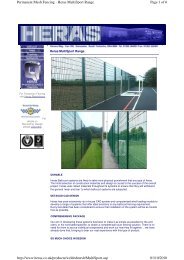Supporting Documentation - Renfrewshire Council
Supporting Documentation - Renfrewshire Council
Supporting Documentation - Renfrewshire Council
Create successful ePaper yourself
Turn your PDF publications into a flip-book with our unique Google optimized e-Paper software.
3.6 Visibility<br />
Visual analysis of the proposed development is carried out in three stages:<br />
1. Zone of Theoretical Visibility<br />
2. Viewpoints<br />
3. Visualisations<br />
3.6.1 Zone of Theoretical Visibility<br />
The Zone of Theoretical Visibility (ZTV) identifies where the proposed wind turbine can theoretically be<br />
seen and gives a good indication of the broad area this visibility extends too. The ZTV represents visibility<br />
as though the ground surface was bare, not considering screening from trees, buildings etc. The earth<br />
curvature and refraction of light affect the visibility over a great distance. This was not calculated during<br />
the ZTV for the farm which means the visibility will be over calculated.<br />
As recommended, in the SNH Visual Representation of Wind Farm report, for a turbine height of 45.9m to<br />
the tip, the ZTV distance of 15km was used from the centre of the turbine. The target height (turbine) was<br />
taken to be centred over the base of the wind turbine. The Hub and Blade Tip Zone of Theoretical<br />
Visibility map is shown in Appendix H. Visibility is constrained from the North East and South of the<br />
turbine. Potential visibility extents North and West with the hub being visible 15km away. Just because a<br />
development is seen does not mean it is a significant visual impact.<br />
The SNH Visual Representation of Wind Farm report states that at 10km from a turbine, the nacelle detail<br />
cannot be identified. At 15km, the blade movement would be unnoticed to a casual observer.<br />
Taking the above note into account, along with the ZTV results illustrated in Appendix H, the properties in<br />
close proximity of the turbine will evidently have the most prominent view of the turbine. However, it is<br />
anticipated that the visibility of the wind turbine will not generate a substantial concern to the visual impact<br />
of the local community and out with.<br />
3.6.2 Viewpoints<br />
Viewpoints are selected places from which the proposal may be seen. Viewpoints are used to assess the<br />
existing visual resource, sensitivity of this resource to wind development, and predicted appearance of<br />
the final proposed development.<br />
A viewpoint can be representative or specific. A representative viewpoint illustrates a range of views that<br />
will see the proposed development. Specific viewpoints are views from a specific location, such as local<br />
visitor attractions, settlements, routes valued for their scenic amenity and places with cultural landscape<br />
association.<br />
Three viewpoints were selected as part of the visual analysis. Their locations are shown in Appendix G.<br />
A photograph was taken from each point towards the proposed turbine position representing the existing<br />
view from this location. Further visualisations were carried out as explained below.<br />
As can be seen in the visualisations, the view of the turbine location from each of the viewpoints proves<br />
not to be intrusive.<br />
3.6.3 Visualisations<br />
Visualisations are illustrations that represent the observer’s view, from the above viewpoints, of the<br />
proposed wind turbine, such as photomontages, wireframes and photographs.<br />
Waterman Group, Renewable Energy, 2/4 Canning Street Lane, Edinburgh, EH3 8ER T:0131 221 7020<br />
16<br />
K:\Projects\CIV12920_ILI Windfarms_Batch 7\CIV12920_XXX_Hartfield<br />
Farm\Documents\Reports\CIV12920_1202xx_Hartfield_<strong>Supporting</strong> Turbine Assessment_225kW.docx


